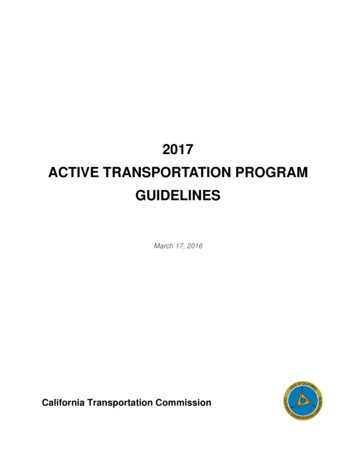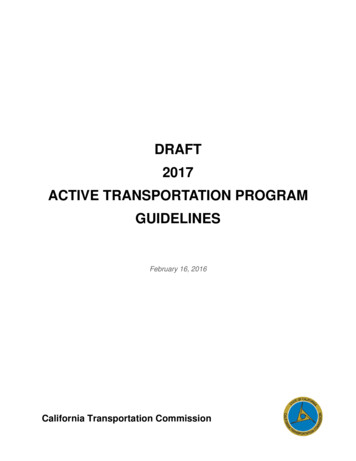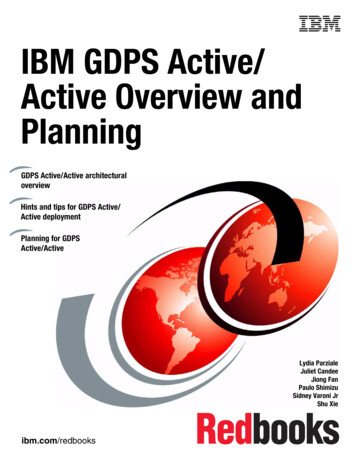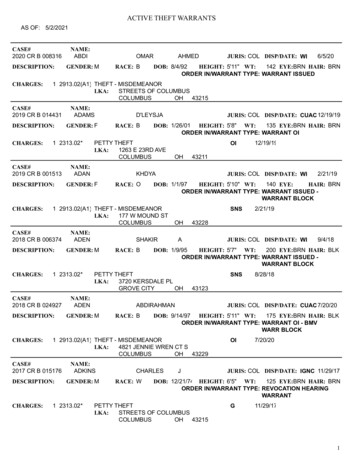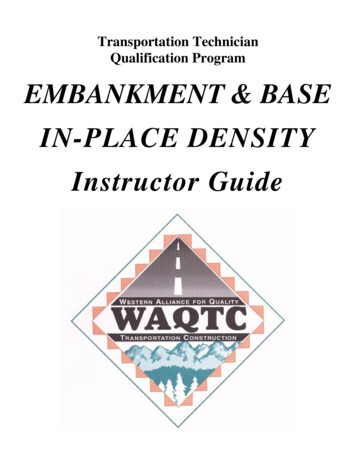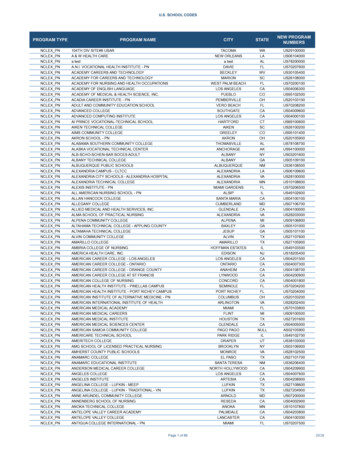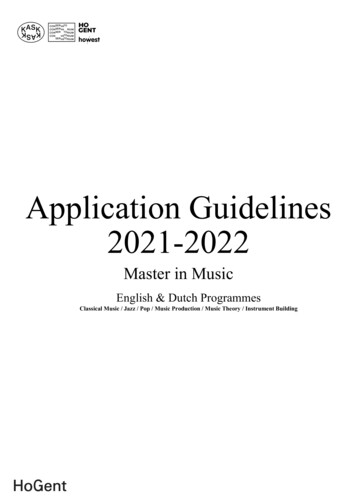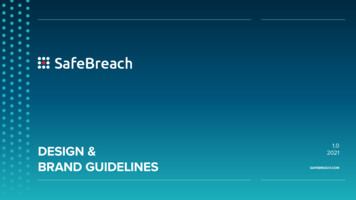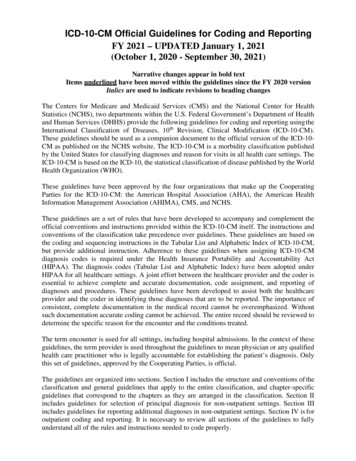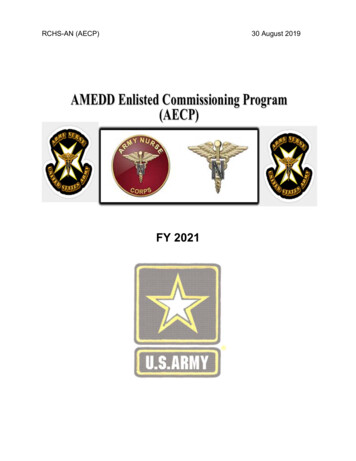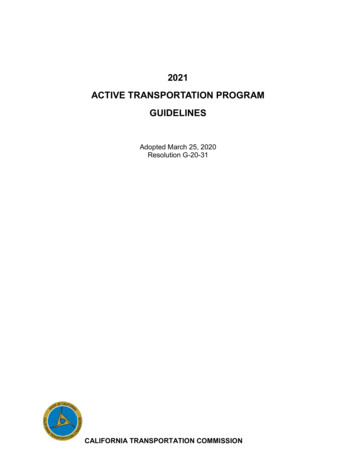
Transcription
2021ACTIVE TRANSPORTATION PROGRAMGUIDELINESAdopted March 25, 2020Resolution G-20-31CALIFORNIA TRANSPORTATION COMMISSION
2021 ACTIVE TRANSPORTATION PROGRAM GUIDELINESTABLE OF CONTENTSI.II.Introduction. 11. Background . 12.Program Purpose and Goals. 13.Program Schedule . 2Funding Overview . 34. Funding Source. 35.Programming Cycle . 36.Distribution . 37.Matching Requirement. 48.Leveraging Funds . 59.Funding for Active Transportation Plans. 510. Reimbursement . 5III. Eligibility . 611. Eligible Applicants . 612. Partnering with Implementing Agencies . 713. Eligible Projects . 714. Eligibility Screening Criteria . 915. Minimum Request for Funds. 916. Project Type Requirements. 10IV. Project Application. 1217. Application Submittal Requirements. 13V. Project Selection Process. 1418. Project Evaluation Committee . 1419. Project Selection Between Applications with the Same Score . 1520. Scoring Criteria . 1521. MPO Competitive Project Selection . 18VI. Programming . 2022. Program of Projects. 2023. Performance Metrics. 2024. State Only Funding Designation. 2125. Committed / Uncommitted Funds. 2126. Contingency List . 22California Transportation Commission2021 Active Transportation Program GuidelinesiiAdopted March 25, 2020Resolution G-20-31
27. Baseline Agreements. 22VII. Program / Project Amendments . 2328. Amendment Requests . 23VIII.Allocations . 2529. FTA Transfers. 277IX. Project Delivery . 2730. Letter of No Prejudice . 2731. Timely Use of Funds . 2732. Delivery Deadline Extensions . 2833. Federal Requirements . 2934. Design Standards. 3035. Project Inactivity . 3036. Project Cost Savings . 3037. Project Reporting . 3138. Audits . 31X. Roles and Responsibilities . 3139. California Transportation Commission (Commission) . 3140. California Department of Transportation (Caltrans). 3241. MPOs With Large Urbanized Areas . 3342. RTPAs Outside an MPO with Large Urbanized Areas and MPOs withoutLarge Urbanized Areas . 3443. Project Applicant. 34XI. Program Evaluation. 35XII. Appendix A: Guidance for Plans. 36XIII. Appendix B: Example Projects . 39XIV. Appendix C: California Conservation Corps ATP Program . 41XV. Appendix D: Guidance for Pilot Quick-Build Project Program. 46XVI. Appendix E: Links Throughout Guidelines . 50California Transportation Commission2021 Active Transportation Program GuidelinesiiiAdopted March 25, 2020Resolution G-20-31
I. Introduction1. BackgroundThe Active Transportation Program (ATP) is a competitive statewide program created toencourage increased use of active modes of transportation, such as biking and walking.Senate Bill 99 (Chapter 359, Statutes of 2013) and Assembly Bill 101 (Chapter 354,Statutes of 2013) created the ATP, and Senate Bill 1 (SB 1) (Chapter 2031, statutes of2017) directs additional funding from the Road Maintenance and Rehabilitation Accountto the ATP.These guidelines describe the policy, standards, criteria, and procedures for thedevelopment, adoption, and management of the ATP. The guidelines were developed inconsultation with the ATP workgroup. The workgroup includes representatives from theCalifornia Department of Transportation (Caltrans), other government agencies, andactive transportation stakeholder organizations with expertise in pedestrian and bicycleissues, including Safe Routes to School programs.The California Transportation Commission (Commission) may amend the ATPguidelines after conducting at least one public hearing. The Commission must make areasonable effort to amend the guidelines prior to a call for projects or may extend thedeadline for project submission to comply with the amended guidelines.2. Program Purpose and GoalsPursuant to statute, the purpose of the program is to encourage increased use of activemodes of transportation, such as biking and walking. The goals of the ATP are to: Increase the proportion of trips accomplished by biking and walking. Increase the safety and mobility for nonmotorized users. Advance the active transportation efforts of regional agencies to achievegreenhouse gas reduction goals as established pursuant to Senate Bill 375(Chapter 728, Statutes of 2008) and Senate Bill 391 (Chapter 585, Statutes of2009). Enhance public health, including reduction of childhood obesity through the useof programs including, but not limited to, projects eligible for Safe Routes toSchool Program funding. Ensure that disadvantaged communities fully share in the benefits of theprogram. Provide a broad spectrum of projects to benefit many types of activetransportation users.In addition to the goals listed in statute, the ATP will also consider state goals andprovisions set forth in Executive Order N-19-19 including state housing goals.California Transportation Commission2021 Active Transportation Program Guidelines1Adopted March 25, 2020Resolution G-20-31
3. Program ScheduleEach program must be adopted not later than the date designated in statute of eachodd-numbered year; however, the Commission may alternatively elect to adopt aprogram annually. The following schedule lists the major milestones for thedevelopment and adoption of the 2021 ATP:ATP MilestonesDateDraft ATP Guidelines presented to CommissionJanuary 29-30, 2020Draft ATP Fund Estimate presented to CommissionJanuary 29-30, 2020Commission hearing and adoption of ATP GuidelinesMarch 25-26, 2020Commission adopts ATP Fund EstimateMarch 25-26, 2020Call for projectsMarch 25-26, 2020Large MPOs submit optional guidelines to CommissionMay 15, 2020Commission approves or rejects MPO guidelinesJune 24-25, 2020Project applications deadline (postmark date)June 15, 2020Staff recommendation for statewide and small urban and ruralportions of the program postedNovember 16, 2020Commission adopts statewide and small urban and ruralportions of the programDecember 2-3, 2020Projects not programmed distributed to large MPOs based onlocationDecember 2020Deadline for MPO Draft project programmingrecommendations to the CommissionJanuary 18, 2021Deadline for MPO Final project programmingrecommendations to the CommissionApril 2, 2021Commission adopts MPO selected projectsMay 2021** Exact dates will coincide with the Commission’s adopted 2021 meeting calendar.California Transportation Commission2021 Active Transportation Program Guidelines2Adopted March 25, 2020Resolution G-20-31
II. Funding Overview4. Funding SourceATP is funded from various federal and state funds appropriated in the annual BudgetAct: 100% of the federal Transportation Alternative Program funds, except for federalRecreation Trail Program funds appropriated to the Department of Parks andRecreation. 21 million of federal Highway Safety Improvement Program funds or otherfederal funds. State Highway Account funds. Road Maintenance and Rehabilitation Account (SB 1).In addition to furthering the purpose and goals of this program, all ATP projects mustmeet eligibility requirements specific to at least one ATP funding source.5. Programming CycleEach ATP programming cycle will include four years of funding. New programmingcapacity for the 2021 ATP will be for state fiscal years 2021-22, 2022-23, 2023-24 and2024-25.6. DistributionState and federal law segregate the ATP into multiple, overlapping components. TheATP Fund Estimate must indicate the funds available for each of the programcomponents. Consistent with these requirements, the ATP funds must be distributed asfollows:1) Forty percent to Metropolitan Planning Organizations (MPO) in urban areas withpopulations greater than 200,000.o These funds must be distributed based on total MPO population. The fundsprogrammed and allocated under this paragraph must be selected through acompetitive process by the MPOs in accordance with these guidelines.o Projects selected by MPOs may be in large urban, small urban, or rural areas.o A minimum of 25% of the funds distributed to each MPO must benefitdisadvantaged communities.California Transportation Commission2021 Active Transportation Program Guidelines3Adopted March 25, 2020Resolution G-20-31
o The following statutory requirements apply specifically to the SouthernCalifornia Association of Governments (SCAG): SCAG must consult with county transportation commissions, theCommission, and Caltrans in the development of competitive projectselection criteria. The criteria used by SCAG should include consideration of geographicequity, consistent with program objectives. SCAG must place priority on projects that are consistent with plansadopted by local and regional governments within the county where theproject is located. SCAG must obtain concurrence from the county transportationcommissions.2) Ten percent to small urban and rural areas with populations of 200,000 or less.Projects are competitively awarded by the Commission in these regions. Federallaw segregates the Transportation Alternative Program into separate small urbanand rural competitions based upon their relative share of the state population.o Small urban areas are those with populations of 5,001 to 200,000. Rural areasare those with populations of 5,000 or less.o A minimum of 25% of the funds in the Small Urban and Rural programs mustbenefit disadvantaged communities.o If a project is eligible for the MPO component, it cannot be eligible for fundingin the Sma
2017) directs additional funding from the Road Maintenance and Rehabilitation Account to the ATP. These guidelines describe the policy, standards, criteria, and procedures for the development, adoption, and management of the ATP. The guidelines were developed in consultation with the ATP workgroup. The workgroup includes representatives from the California Department of Transportation .
